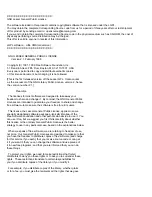
42
Basics Section
Quick Guide
Refer
ence
Appendix
Voice Edit
3
Set the Common
Parameters
Each Voice consists of up to four Elements. Here, the
parameters common to all Elements are explained.
●
GENERAL (Common General)
In PAGES 1 to 4, you can set the Voice Name, Voice
output settings and other general parameters.
●
CONTROLLER (Common Controller)
In PAGES 5 to 10, you can assign and set various
functions for the controllers on the front (such as
the Modulation and Pitch Bend Wheels) and the
controllers connectable to the rear panel. For
example, you can assign parameters to the
Modulation Wheel so that you can change the tone
of Voice in real time. For details about different
controller uses, see page 38.
●
EFFECT (Common Effect)
In PAGES 11 to 17, you can set the Effects
parameters for the Voice. There are System Effects
(Reverb and Chorus) and Variation Effects.
4
Set the Element
Parameters
n
The Element settings whose Element Switch is set “off”
cannot be changed and “***” appears in the display.
Monitoring the Element for Editing
(Checking the Voice Structure and Muting)
Since Voices are made up of a maximum of four
Elements, you can better hear the edits you make by
setting only the Elements you are editing to sound.
Check how many Elements are used with the steps
below.
n
You can also check the number of Elements
used by referring to the Voice List in the
separate Data List.
1
In the Voice Edit mode, press the [+] or [–]
button to switch to the Element Edit display.
2
Use the [
] button to switch to the Element Sw
screen (PAGE 1).
3
Move the cursor to the desired Element by using
the [+]/[–] buttons. The voice being edited is made
up of the Elements which are indicated by “on.”
For example, you can check which Elements create
which specific sounds in the case of a Voice made up
of Elements 1 and 2 — following the steps below.
4
Move the cursor to Element 1 (E1) by using the
[–] button.
5
Press the [MUTE] button. E1 flashes and the
selected Element is muted. When you play a key,
only Element 2 will sound. Cancel mute by
pressing the [MUTE] button again.
6
Move the cursor to Element 2 (E2) by using the
[+] button.
7
Press the [MUTE] button. E2 flashes and the
selected Element is muted. When you play a key,
only Element 1 will sound. Cancel mute by
pressing the MUTE button again.
By performing the above operation, you can check
the sound of the specific Element you wish to edit,
and mute the other Elements so that you can clearly
hear the changes you make.
After you finish editing, cancel muting for all
Elements. Now, all the Element sounds (including
the one you edited) are mixed — letting you hear
how the changes you made affect the overall sound
of the Voice.
●
OSC/MIX (Oscillator/Mix)
In PAGES 1 to 6, you can set the various parameters
controlling the waveforms on which the Voice is
based. You can select the Wave used for the
Element, the volume and note range of each
Element and so on.
Element Sw (Element Switch)
Determines whether each Element sounds or not.
Wave Number
Select the Wave for each Element.
Level
Pan
Set the volume (output level) and stereo pan
position of each Element.
NtLmt-L/H (Note Limit Low/High)
VelLmt-L/H (Velocity Limit Low/High)
Set the note range for each Element (the range of
notes on the keyboard over which the Element will
sound) and also the velocity response (the range of
note velocities within which the Element will
sound). You can assign different settings for each
Element. With these parameters, you can layer
Elements and control their output.
Effect
AMP
FILTER
PITCH
OSC
Element
1
~
4
PEG
FEG
AEG
LFO
Element Edit Process
















































